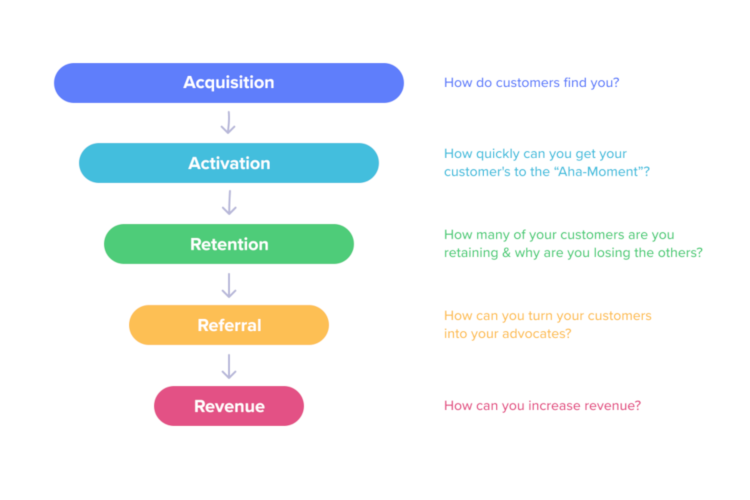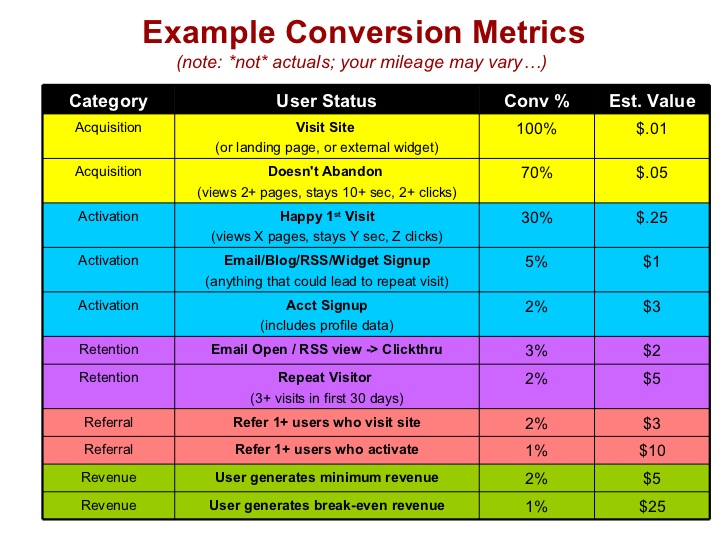
In my last post, I explained the Growth Hacking mindset and briefly touched on AARRR Pirate Metrics for startups. For this article, I’m going to break down what the AARRR Pirate Metrics are, why they matter to startups, and why they are key to Growth Hacking.
In the recent posts we also discussed the details of how to make Inbound Marketing work for your business, and also explained Outbound Marketing, where we elaborated on the pros and cons of each. AARRR pirates metrics are the foundation in all of these approaches: Growth Hacking, Inbound Marketing and Outbound Marketing.
Table of Contents
What Are AARRR Pirate Metrics?
- Acquisition: Getting Visitors
- Activation: Converting Visitors
- Revenue: Being Profitable
- Referrals: Multiplying Customers
- Retention: Keeping Customers
Roles for each stage of AARRR
Adopting the Growth Hacking Mindset
What Are AARRR Pirate Metrics?
Back in 2007, successful founder Dave McClure coined the term “Pirate Metrics”. He used the catchy term to refer to the acronym AARRR, which stands for Acquisition, Activation, Retention, Referral, and Revenue.
These five metrics all have one thing in common: they are absolutely critical for a startup’s success–and for businesses in general. If a business fails to track these metrics, they will lack both sustainability and scalability, and they’ll have no way to know if they are performing well.

Pirate Metrics AARRR Funnel
Each of the AARRR metrics represents an area, from attracting more visitors to your business, to generating more revenue. The areas do not overlap, and form a perfect sequencing, that when mastered, will make sure your business is prepared to be as efficient as it can.
Let’s dive deeper into each of the areas and how to best address them:
Get our Comprehensive “Inbound Marketing Plan” Template.
Fast-track your Inbound Marketing strategy with our meticulously designed, premium tool.
Visit our homepage to explore more about this indispensable asset!
Acquisition: Getting Visitors
Acquisition is an on-going effort, and it tends to involve channels like social media, SEO, PPC, affiliates, and traditional radio/TV/print. Any channel that could potentially lead a customer to your business could be considered an acquisition channel.
In its simplest form, businesses’ acquisition efforts will include multiple inbound and outbound campaigns in order to drive traffic to a product, website, or landing page. These efforts also need to include metrics about conversions coming from each channel in order to gauge success.
These metrics may be focused on things like page visits, which are considered low-value, or things like micro-conversions where the person ended up clicking on a product or watching a video about it. Bounce rate is also an important metric for landing pages. All of these metrics help a business measure the quality of their traffic and overall user behavior, which can be tracked with a tool like Google Analytics.
The acquisition phase is about building awareness and attracting the right people to your product using a few basic metrics to track their actions. The main goal is to go from Page Visits, to Demo Requests, or Contact-Us requests, whichever metric you defined as the passing point from Marketing to Sales, and that defines a SQL (Sales qualified lead).
Activation: Converting Visitors
The activation phase is all about engaging the previously acquired visitors so that they understand your product/brand and, ultimately, want more: the “Aha! moment”, where they understand the value that your product delivers.
With the activation phase, the focus really is on conversions: from visitor to customer. What a business cares about are the primary metrics that will let them decide how successful a particular campaign or channel is. This is more important than micro-conversions or high-level conversions that were measured in the last phase, since it will more easily translate into revenue.
An activated user will arrive at your website thanks to your acquisition efforts. They will indicate that they see your product’s value by opting to receive more information. Next, they will talk to someone at the company or try the product out. That’s an example of an activated conversion.
To start, a business might consider the conversions from their home page to their signs page, but ideally, you should put your whole conversion funnel into the analytics tracking tool you’ve chosen. Think of the funnel that tracks: Visitor -> MQL -> SQL -> Opportunity -> Customer.
The activated conversion is when the customer/business relationship really begins. Prior to this event, the customer is really just anonymously browsing the website. Up to this point, they haven’t taken an action that enables the business to engage with them directly.
A business should measure activation based on the number of site visitors who fulfill a desired action, like requesting a trial or signing up for a newsletter. A simple conversion formula can be created by dividing the number of “active users” by the number of visitors on the website.
Retention: Keeping Customers
Visitors need to stick around, and there’s one key reason why. You have probably learned in the past that, for businesses not selling high price items, the key to a successful and sustainable business is repeated business. You cannot continue to invest in the acquisition phase and completely disregard retention.
Getting a customer to make a purchase is the first goal, but follow-up is key to ensure they come back for a future purchase too. Being able to track retention varies from business to business.
For a mobile app designer with free games, retention is about how many visitors use the app more than once. Since advertising revenue will grow with user volume, retention is key for them because “sticky” users will make for sustainable profits from the freemium app.
On the other hand, an eCommerce company that sells seasonal items will measure retention based on how many people come back from one season to another.
Different still, a SaaS company’s retention is going to be focused on churn, which is when a customer quits or downgrades from a service. For those companies, this is by far the most important metric and reducing it is constantly a top priority for the business.
By far, your business’ retention metrics are the most important metrics to both track and understand. That’s because these numbers demonstrate how valuable your business is to customers, and they can also lead you to the key areas that need improvement.
If your business has poor retention rates, that’s going to lead to scaling difficulties. Poor retention will also lead to a business facing issues with sustainability and general profitability since the cost to acquire a new customer is multiple times more expensive than keeping a current one that you have already acquired.
Plus, once you get your retention levels up, you can focus on the next aspect: referrals.
Referrals: Multiplying Customers
Every business owner’s dream is to have their customers refer their friends and family to the business. That’s because not only is this the cheapest way to acquire a new customer, but a referral is also the most genuine method for a visitor to be introduced to a business.
Customer referrals are an excellent acquisition method, but most marketers find that being able to measure new referrals is difficult. Figuring out how to set up an analytics tool to track conversions and referrals is tough in itself. It can be even hard to incentivize customers who bring in referrals, and the referrals who result from the process.
So, this metric is often imperfect, but that doesn’t make it any less important to try to keep up with it.
For completely online businesses (like SaaS companies and eCommerce stores), tracking referrals is a tad bit easier. App owners can also track referrals with ease, and the most popular method is to use a unique code given to each current customer. When a person wants to refer someone, they give their code to that person who types it in during signup or shares it with a representative at the company.
The reason why users go through the trouble of sharing their code is that the company offers an incentive. That might be a discount, free gift, or something else that entices both the current customer and the referred person to let the company know about the recommendation.
Obviously, the referral program needs to be profitable for the company. But, setting up a referral program that generates revenue can be trickier than it first seems, and that brings the Pirate Metrics process to the final aspect.
Revenue: Being Profitable
Revenue is the main goal of every business. Just about every activity a business engages in has to somehow be tied to ROI and be measured to ensure it is contributing to a successful and profitable business venture. Even a venture-backed startup is going to need to think about revenue.
Of course, not all revenue is measured exactly the same. Tracking bottom-line and top-line revenue is important for business growth. The majority of businesses out there look at total numbers, overall, rather than breaking things down per customer, ie, ARPU (average revenue per user). However, the latter is a much more effective and powerful approach to take.
When you measure profitability per customer, you’ll be able to discover which customers are breaking even and which are not. That lets you send the right messages to each customer, thus improving revenue and decreasing the number of lost opportunities.
When a business is savvy with their analytics, they can even build a complete marketing funnels that enables them to track their spend per channel along with correlating profitability. This beats relying on basic metrics, like cost-per-lead and cost-per-acquisition, any day of the week.
A business that neglects to measure revenue per customer and revenue per channel is basically flying blind. Neglecting to measure these two metrics means the business is not able to effectively allocate the marketing budget and is in the dark regarding a lot of improvement opportunities for business operations.
From day one, most startups are going to be revenue focused (unless they are fully venture-backed and just care about product). This means that knowing how to measure revenue per channel and revenue per customer will prove to be worthy feats. Even for those venture-backed startups, these two metrics will enable the company to raise more capital in the future.
These crucial metrics give a startup the ability to scale rapidly and sustainably.

Pirate Metrics examples
Get our Comprehensive “Inbound Marketing Plan” Template.
Fast-track your Inbound Marketing strategy with our meticulously designed, premium tool.
Visit our homepage to explore more about this indispensable asset!
Roles for each stage of AARRR
In the Pirate Metrics process, the first step of Acquisition is typically the only piece of the Pirate Metrics process that traditional marketer focus on, since it represents businesses’ lead-generation.
The marketer might also be involved in the next step of the Pirate Metrics process, Activation, if for example he is doing lead-generation for the creation of free accounts. If to convert a visitor to product user, the business needs a more complex closing process, than that’s the Sales Department expertise.
The Retention phase is mostly the domain of the Product Team, being responsible for keeping users engaged with the product, and using it. A good product is one that the customer will feel they can’t live without, or one that their live would be worst out, if they could not use it!
The Sales team is responsible for generating the Revenue. In a simpler SaaS model, it means converting from a lead, to a customer. In a more complex freemium model, the Product team is also involved in the Revenue stage, since it would be product features and upselling mecanisms, that will migrate a user from a free tier, to a paid tier.
Depending on the type of product, Referrals can be baked into the product itself, or they can be requested by Sales or Marketing teams.
A Growth Hacker would be interested in covering all the areas of the funnel, regardless of their role. The growth hacking initiatives would cover Marketing, Product Management, Sales, and Customer Success. Normally Growth teams are comprised of several different roles, to have significant expertise in each of the AARRR stages.

Company areas that a growth team intersects
Adopting the Growth Hacking Mindset
As I’ve discussed before, the concept of Growth Hacking is all about growing with the help of engineering, design, data, and marketing. Those last two are really where the powerful overlap occurs between the Pirate Metrics process we’ve just discussed and the Growth Hacking mindset that I think is critical to implement.
1. Measure
While there is more than just metrics to the Growth Hacking mindset, they are definitely at its core. AARRR metrics will serve as the base for the growth metrics that you want to collect and improve upon.
The great thing about Pirate Metrics is that they cover the entire customer journey, from stranger to evangelist. These are the metrics that will steer you away from toying with vanity metrics, and focus on those that drive value creation for the business.
These (AARRR metrics) are the metrics that will steer you away from toying with vanity metrics, and focus on those that drive value creation for the business.
– The way of Damasio
2. Analyze
When it comes to Growth Hacking, the way that you’re going to use Pirate Metrics in conjunction with the experimentation mindset is to use all the tools available to you in order to measure all the critical metrics you need to know. With those measurements, you’ll be able to collect a substantial amount of data.
It’s through the collection of that data that you’ll be able to analyze it and, more importantly, act on it. The data you collect can be used to form experiments and make changes so that you can find opportunities for improvement. Basically, you’re going to hack each stage of your growth funnel.
3. Generate experiments for each stage
By collecting data, you’ll understand which areas as showing healthy signs, and improving considerably by doing “Business-as-Usual”, and which areas as behaving as bottlenecks and need to be addressed.
A good initial approach is to focus on a different stage of the AARRR metrics, per month, and only do experiments to improve that stage’s main KPI. That will give you the most leverage, by having foccus, and knowing that you’ll go through the other stages of AARRR metrics, in due time.
Pick out what experiments to roll out, by prioritizing your experiments with the ICE Score: Impact; Confidence; Easiness to Implement.
- Impact: how much impact do you estimate the experiment will have.
- Confidence: how confident are you that it will turn out a positive experiment.
- Easiness to Implement:how easy will it be to implement the experiment.
4. Check Progress
With the use of weekly growth meetings, your business will sit down to look at the most recent AARRR metrics and their trends over time. This will allow your company to see what may need to be improved upon in the future and if your changes in the past X months have been making a positive impact.
The growth master is going to be the person who conducts the growth meetings. This is the person who is in charge of the growth process for the business. The main focus of the growth meetings is to keep the process moving forward and ensuring that the growth team doesn’t run out of experiments to try. Time frames also need to be respected and the meetings check that each experiment owner is properly managing their own experiment.
To properly measure progress, have a benchmark before rolling out the experiment, ie, have an average measurement of the KPI (key performance indicator) that you’re trying to improve, to make sure that the change can be attributed to the new experiment. By having a stable value changing considerably, it clearly shows that the experiment had impact in improving the KPI.

Weekly growth meeting agenda
5. Revise and Review
With the growth meetings, the leaders at your business will gradually make revisions and then review the updated AARRR metrics to see how those changes influence the company’s growth and profitability within a given timeframe. Working together, the team will be able to identify what changes were positive and which ones did not make a positive impact on the business.
These simple, one-hour growth meetings will allow the business to keep pace with its competitors and slowly grow out of the startup phase as it sets its sights on bigger revenue goals. That’s all thanks to the use of the Growth Hacking mindset built upon AARRR metrics.
To know more about Growth Hacking and how to best apply it to your business, read my previous blog post: My approach to Growth Hacking.
Get our Comprehensive “Inbound Marketing Plan” Template.
Fast-track your Inbound Marketing strategy with our meticulously designed, premium tool.
Visit our homepage to explore more about this indispensable asset!
Share now :


